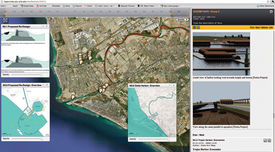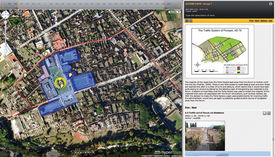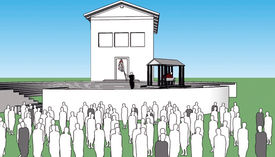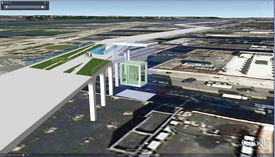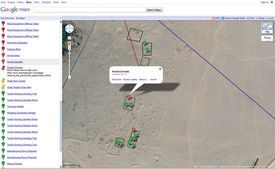5. Teaching Digital Humanities through Digital Cultural Mapping
Chris Johanson and Elaine Sullivan, with Janice Reiff, Diane Favro, Todd Presner and Willeke Wendrich
“The Emerald Buddha: Politics, Religion and Buddhist Imagery in Southeast Asia;” “High Line New York City: An Economical and Cultural Revival;” “Mapping Mami Wata: The African Water Goddess;” “Mapping the Bilbao Effect”—all of these were final project proposals by undergraduate students in UCLA’s three-year Digital Culture Mapping Program sponsored by the W. M. Keck Foundation (http://www.keckdcmp.ucla.edu/). These projects showcase how students envision harnessing digital technologies to address a broad range of questions in the arts, humanities and social sciences. While the range of student interests in digital projects was exciting, it revealed an underlying tension: should the digital or the humanities win out? To wit, our areas of domain-specific expertise include Egyptian archaeology, the history of Los Angeles and Chicago, Roman culture and literature and the city of Berlin, but we had only superficial familiarity with, for example, African water spirits. How does one teach students the digital tools to address such a wide variety of projects without neglecting traditional discipline-specific issues of research formulation and data collection? How can one honestly and effectively evaluate student projects for content that lies outside one’s domain expertise? While fully acknowledging that teaching a technological skill set can lead students to ask new and original questions of cultural data, when and in what instances must we nonetheless start with a domain-specific research question, and then move to teaching the digital?
This chapter will outline the process we employed to address these questions as we developed a multi-track program centered on digital humanities at the University of California, Los Angeles (UCLA). Driving our curriculum is the belief that informatics, spatial modeling, time-space visualizations and the like should be utilized not only as ends in themselves, but also as tools and methods that contribute, at least in part, to current scholarly conversations in more established disciplines. We are humanists, after all.
First, we describe what we have already accomplished by examining the different ways we have collectively and individually approached the question of teaching digital tools, methodologies and theories in our classrooms—both in the multi-quarter series of digital mapping classes team-taught in 2009–2011 at UCLA, as well as in classes developed over the last decade and offered within our own subject disciplines. Second, we explore how this introductory program has formed the foundation for subsequent phases in digital humanities pedagogy at UCLA. Rather than begin a degree-granting program at the undergraduate and graduate levels, we have first introduced curricular offerings that mirror our own varied, individual paths through digital humanities. Building on traditionally-defined humanities-based training, we have each identified a specific area of research, attempting not only to ground emerging digital technologies in traditional fields of humanistic inquiry, but also to combine the critical-thinking skills and intellectual openness characteristic of the humanities with the team-based problem solving and collaborative, hugely social nature of digital platforms. After reaching the end of our three-year digital mapping curriculum, we see the successful expansion of the program into an undergraduate minor in digital humanities as a way to foreground the humanities in the development of the evolving definition of the digital humanities.
The Keck Digital Cultural Mapping Program: Goals and Curricula
UCLA’s Digital Cultural Mapping Program (DCMP) emerged from a desire to introduce undergraduate students to the potential for using new technologies and theoretical approaches in research and knowledge acquisition. Three- and four- dimensional digital modeling, Geographic Information Systems (GIS), virtual globes and a host of newly conceived and rapidly developing mapping tools—all traditionally used by those outside the humanities—are now being harnessed to investigate questions relating to these disciplines.1 We believe that the ability to understand, analyze, critique and create these technologies is essential for twenty-first century students, who will be increasingly asked to evaluate materials produced and presented through these digital media.
The project focuses on three main pedagogical goals:
- To teach students how to understand, utilize and critique the tools and technologies related to the geospatial/geotemporal web, that is, to equip them with a form of geospatial, digital literacy;
- To provide students with the technological tools to evaluate and to contribute to digital mapping projects in the humanities; and
- To teach professional vision, that is, to develop students’ critical thinking skills and visual sophistication as they relate to material presented in a spatial and/or temporal format.2
In order to achieve these aims, we introduced a set of “core” skills we deemed necessary for fluency in the geospatial humanities. Core Course A, the first in the three-quarter series, lays down the intellectual foundations for the program, introducing students to the history and development of the visual presentation of data. The course centers on data representation through mapping, reasoning and critique, asking students to create and analyze data presented in a spatial format.3
Core Course B, designed as a lab, offers students direct instruction on a number of mapping platforms. Existing scholarly projects that use two-dimensional online mapping, virtual globes, three-dimensional modeling and GIS are introduced and analyzed, acquainting students with the variety of research questions currently being addressed by these technologies. Students are then asked to use these programs creatively and to design their own projects based on datasets from their area of academic interest. Each project builds on the skill set learned in the previous week, with the course culminating in a final GIS project designed by each student. In order to address a specific question within their discipline, students gather a dataset, input the information into a GIS, and create an argument about their results. Past projects include: investigating the impact of New York City’s High Line project on the surrounding community, the correlation between school failure and location in modern Los Angeles, and the democratization of funerary literature in ancient Egypt. By utilizing these new techniques in digital mapping, our humanities and social science students are grappling with how spatial and temporal factors are crucial to understanding place.
The final core class, Core Course C, offers a small-group, research “capstone” experience for undergraduates, in which students work closely with faculty members on an ongoing research project, utilizing the critical thinking and technological skills learned in the Core A and B classroom.
The strength of the Keck Digital Cultural Mapping Program lies not in the “core” courses, however, but in the integration of spatial concepts and mapping technologies into new and existing classes at UCLA. The Keck faculty is committed to adding new digital mapping elements to its current classes to transform these traditional humanities and social science classes into collaborative and interactive learning spaces. Additionally, by recruiting a group of associated faculty and offering them instruction and ongoing classroom support for the use of these technology programs, the Keck DCMP has expanded incrementally.
Challenges Integrating Digital Toolsets in Humanities Instruction
Integrating the teaching of robust and sophisticated digital tools into a modern undergraduate program will never be straightforward. Contrary to glib, but seemingly intuitive assessments of our twenty-first century students, those born in a post-Internet world are certainly sophisticated consumers of well-designed, commercial technology, but their march through the primary and secondary school systems has not prepared them to develop and analyze complex digital arguments.4
The university system exacerbates the problem. If students have not received a rudimentary technical introduction in secondary school, remedial training is clearly warranted. The curricular demands of a research university such as UCLA—and the same doubtless holds true for small liberal arts colleges—do not easily allow for a seminar or a lecture course to focus solely on technological approaches. A quick scan through course offerings at any major research institution illustrates the issue: there is only a scattering of lab courses devoted to purely technical training. Even in the computational sciences, it is difficult to find a course entitled, “An Introduction to X Language.” Instead, one finds “An Introduction to Computer Science” or “Software Construction Laboratory,” and only by browsing the current syllabus will the case-study language be apparent. To belabor an obvious point: there was an art and science to using a complicated scientific calculator, but understanding the math and the potential problems to be solved is the only way to even begin to understand how to get work done. Even when teaching a fairly robust tool, one must focus primarily on the theory underlying it. Teaching the tool alone can lead to a tool-specific, rather than a theoretical approach to problem solving.5
Practical demands of tool acquisition cannot simply be brushed aside, however. Modern software, which should be conceived in its broadest forms, ranging from cloud-based (or whatever the next decade’s terminology will call it) to systems installed on a local machine, can be deceptively easy to use, but its capabilities require a theoretically complex understanding to exploit. Every software package has a learning curve, and some—especially in the realm of geographic information systems or statistical analysis—are well known for being almost user-unfriendly. Students cannot be expected to apply even rudimentary GIS-based theory within the confines of such an extraordinarily counter-intuitive program as any of the current GIS solutions, regardless of whether they use open source, free, or for-pay software. Such a tool cannot easily be taught, nor can it easily be mastered.
In walks the digital humanist. The following brief thought experiment illustrates the unfortunate ramifications of a tool-based course in the humanities, with no better place to start than an introductory programming class. One might offer a class on “mapping for archaeologists,” or “programming for humanists,”6 but if one were to offer a course entitled “Java for humanists” what might be the result? What is the result of offering a course such as Latin for medical students, or an introduction to the German language for students of intellectual history? The courses are indeed useful, but learning outcomes are in no way comparable to those of introductory language courses. If we were to devote a humanities class to similar training on a tool, we could produce students who use GIS, but who do not understand its full capabilities. Better to learn GIS through a formalized structure run outside the humanities curriculum, and focus the precious time allotted to the humanities on issues humanists can do best. If the effort were simply to teach an army of semi-competent programmers, then the digital humanities would be an abject failure.
If, however, the definition of the digital humanist includes a deeper understanding of the present set of software affordances—in order to suggest, first the right theoretical approach, then the right tool for demonstrating and practicing a theoretical concept applicable to the humanities—then, in our view, progress has been made. We are not so much concerned that the student intimately knows specific software—rather we want him or her to understand the conceptual framework of, for example, the geospatial or even the geotemporal web. We wish to avoid teaching the specific details surrounding which key is pressed to draw a point or a polygon in a software program, or, even worse, accidentally conveying that one software company’s approach to geospatial material is the only way, so that the limitations of one software package do not constrain the intellectual research agenda.
Critical to these endeavors at the undergraduate level is the construction and intelligent use of a suite of examples. A new field does not so easily yield exemplary material in sufficient quantity. While it is exciting to imagine that our students, an extraordinarily creative lot, will push the limits within their digital projects, when given an assignment to create a thematic map of their local neighborhood that changes over time, many will struggle without clear examples. Students have been trained to write, and though we often complain that they do not seem to have benefited from such training, nonetheless, the time they have spent writing journal entries, essays, blogs and research papers dwarfs the time they have spent producing analytic, digital investigations. Though students are steeped in a digital, media-driven culture, they have not been trained to interpret and critically evaluate it. Therefore, modeling is critical.7
The tools have changed over the years, but the focus of the courses remains the same: we teach core concepts of analysis and research method. The independent scholar working alone is no longer the only model, however. Digital projects invite a team-oriented, collaborative approach; similarly, the work on specific tools fosters a collaborative spirit and a team-oriented research methodology.
Integrating Digital Tools into Historical Narrative: The LA Cluster
Touring LA, one of a suite of courses designed for the Keck DCMP and now offered as a digital humanities minor elective, is also part of another innovative UCLA instructional initiative: the freshmen clusters. These cluster classes provide first-year students with an opportunity to take a yearlong course sequence on a focused topic delivered from an interdisciplinary perspective. In the first two quarters, cluster courses rely on the lecture/discussion section format familiar to many introductory courses. What is most distinctive about them is that they are team-taught by faculty from up to four different disciplines who approach the topic—ranging from the cosmos, to sexuality, to myth, to the 1960s—from their own perspectives while engaging in interdisciplinary conversations with their colleagues. In the third quarter, students have the opportunity to select a topical seminar taught by one of the teaching team members (made up of lecturers and teaching fellows) from the previous two quarters. These seminars allow most students to choose a topic and methodology of some particular interest to them as well as create a substantial piece of scholarship that rests on the background knowledge gained in the first two quarters. Touring LA was part of GE66: LA—The Cluster, a class designed to introduce students to the complexities of urban environments through the prism of Los Angeles, the students’ home for (at least) the next four years.
Throughout the first two quarters, students engaged with the spaces of Los Angeles from a variety of perspectives. Lectures and readings challenged students to consider them from historical, literary, sociological and legal perspectives. They were introduced to the imagined spaces of city boosters, realtors and novelists, and they researched particular geographic communities for their writing assignments. In the first of these assignments, they wrote a history of a neighborhood or community in Los Angeles County. For the second, they conducted an ethnographic interview of someone who lived or worked in that community and subsequently wrote up their findings. Their last assignment took the form of a letter written to the appropriate government official, in which they documented a problem currently facing that community and suggested a solution. Students began their spring quarter seminar, Touring LA, having surveyed the city of Los Angeles and having developed a rudimentary range of tools for performing city-based research.
Students also received a brief introduction to the importance of tourism for Los Angeles—for bringing prospective residents to Southern California and for bringing tourist dollars and jobs into the economy. These themes were more fully developed throughout the seminar. They read about urban and heritage tourism. They debated whether a tourist bubble really existed in Los Angeles and then unintentionally proved that it did when they began plotting places they wanted to visit on a class-created online map. They were even more surprised when their sites corresponded with the places German and French guidebooks suggested visitors see in Los Angeles. By the quarter’s end, class members had a good sense of the importance of tourism for cities more generally and for Los Angeles in particular.
The largest part of their effort during the quarter—and of particular interest for this chapter—was to prepare their own interpretive tour of Los Angeles. The requirements for creating the individual tours were fairly simple, although the challenge for the students was substantial. First, the tour had to introduce its proposed audience to Los Angeles from a perspective it would not have had otherwise. Second, the tour itself had to include at least ten physical locations in Los Angeles and vicinity. Third, it had to be presented in two formats: a written document equivalent to a tour guide and a digital version, done either in a commercial online mapping program or in the HyperCities platform (http://www.hypercities.com/). The tour itself could be historical or contemporary. In the digital environment, it could be richly illustrated with images, sound or video. What ultimately would determine the success of their individual tours would be the interpretive argument they were making about Los Angeles as they led their tourists through their introductions, the individual sites, and the descriptions that accompanied them.
The assignment was not as simple as it might seem. Students had to do substantial research in order to construct their narratives and to find locations that best reflected and sustained it. The first two quarters’ research had provided them with many potential ideas for tours, but not all of them were well suited for a geographic presentation. Nor did all of those possibilities have what the tourism-savvy students recognized as tourist appeal. That was of some concern to them because their classmates served as critics of their tours at three different times during the quarter: when they first proposed the topic of the tour, after they identified the first five locations, and when the tour was completed. Being freshmen, few had access to cars, making it difficult to visit many of their sites (while enhancing the practical value of the “street view” function in digital mapping platforms).
In the two years this course has been offered (and taught by Janice Reiff, a historian), the students have designed a wide range of fascinating and diverse tours on topics that have shed interesting perspectives on Los Angeles (see Figure 1). One student created an “insider’s guide” to ethnic restaurants in Los Angeles, documenting eateries frequented by neighborhood residents but unknown to trendy Angelenos. Along with good eating tips, her “tourists” also learned about many of the city’s newest immigrants and the neighborhoods in which they lived. Another student provided a surfer’s guide to LA: starting out as simple list of where to surf, the final tour—displayed atop satellite imagery so the visitor could actually see the waves—offered a history of Southern California surfing and surf sites, emphasizing their own distinctive characteristics and characters. Still another investigated and mapped institutional continuities and changes in South Los Angeles as neighborhoods changed from being predominantly African American to Latino.
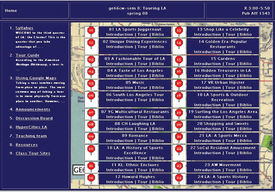
Figure 1. Tours created by students in the 2008 offering of Touring LA.
Although more deserve highlighting, three stand out. One student had, before she enrolled in the class, developed an interest in Howard Hughes after watching the film, The Aviator (2004). Reading his biography, she decided that Hughes’ life story could reveal much about the city so she created her Howard Hughes Tour of LA (Figure 2). It began as Hughes moved, like many Angelenos, from Texas to Los Angeles to seek his fortune. It explored the film, oil, and aerospace industries as well as the spaces Hughes frequented before becoming a recluse in Las Vegas, a site she also pulled into her LA story.
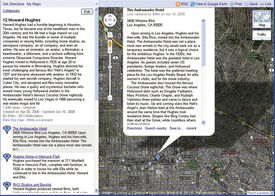
Figure 2. Howard Hughes Tour of LA.
Another began life as a shopper’s guide to Los Angeles but ended as a fascinating presentation on the garment industry. The tour, naturally, ended on Rodeo Drive and Melrose Avenue, but it began in the sweatshops and factories of a very different Los Angeles and moved through union halls and the fashion district before arriving at the high-end retail and resale shops. The act of following the tour documented one of Los Angeles’ largest industries. The single most ambitious project used the tour/map format to engage with the contention of the LA School of urban scholars that their theories about Los Angeles—the archetype for the post-modern American city—had also supplanted the old models of urban theory developed by the Chicago School some seven decades earlier when Chicago seemed to be the archetypal city. Spanning the vast spaces of the Los Angeles metropolitan region, the tour showed that Los Angeles with its historical layers reflected elements of both.
As they completed their projects, the students easily mastered the basics of online mapping and, by necessity, developed basic skills in markup languages, and in transferring their digital maps into social mapping platforms where they could take advantage of historical map overlays to illustrate their points about change over time.8 They struggled with many of the issues cartographers must address when creating maps that are analytical and narrative as well as simply representational. They mined the photo collections at UCLA, the Los Angeles Public Library, the California Digital Library’s Calisphere (http://www.calisphere.universityofcalifornia.edu/), the University of Southern California Library, the Library of Congress, and other places to make their virtual tours richer.
The final learning experience for both classes came on the last day of the quarter. On that day, the students climbed on a bus for a live tour of the sites they, as a group, decided were the most interesting to visit. Both classes had ambitious agendas: a 57-mile trip that took them from Watts Towers to Hollywood, from Leimert Park to Silver Lake, from Angel’s Flight to Pink’s Hotdogs. The second tour was affected by what at least two students had built into their virtual tours—LA traffic. The rain that day cut the planned tour almost in half and introduced students to new, uncharted neighborhoods as the bus driver sought alternatives to the clogged freeways. Fortunately, they also retained the virtual versions to visit the sites at their leisure during their remaining years at UCLA.
Devising Humanistic Experiments: Roman Architecture and Urbanism
Another Keck-related course examined Roman architectural history (taught by Diane Favro, an architectural historian). Based in the Department of Architecture and Urban Design, the class attracted students from such solidly humanistic fields as classics, near eastern languages and cultures, art history and critical studies in architecture, as well as those working to become practicing architects. As a result, the participants displayed not only widely divergent knowledge of history and design, but also widely divergent graphic and spatial literacy. Some students were familiar with historical research, but had no graphic experience; those in architecture had extensive experience with three-dimensional modeling, but none with archaeological analysis; others were experts at dissecting texts, but could not easily read maps. The course adopted a science-based model, emphasizing experimentation based on specific problems. Working in groups, the students selected an issue and developed an experiment to either test a defined hypothesis, or evaluate an alternative solution to architectural challenges relating to the Roman era. As much as possible, the groups were composed of students with different backgrounds and skill sets who worked in concert. The research was formed and presented collaboratively on the geotemporal HyperCities platform, allowing the exploitation of diverse digital media and strategies while maintaining the scholarly apparatus of a research paper.
The incorporation of new technologies compels instructors to ask new questions and reframe old ones, reinvigorating both traditional and digitally based research and pedagogy. For example, ancient architectural historians frequently use architectural reconstructions, but rarely interrogate their accuracy or discuss the context in which they were created. Lectures using multiple digital as well as pictorial reconstructions resulted in conversations about the role of each in knowledge production and their varied applications by researchers, teachers, and the general public. A discussion centered on reconstructions of the Villa of the Papyri in Pompeii compared a physical “rebuilding” at the Getty Villa in Malibu with two digital simulations, one for digital heritage and one for scholarly analysis. In effect, these architectural representations paralleled the comparison of differing outcomes from the same dataset undertaken in the LA cluster. The interrogation of media and sensory experiences also prompted the class to challenge the dominance of vision in traditional architectural history, and argue for more polysensory analysis.
Courses incorporating digital technologies require a rethinking of pedagogical choreography. Lectures remained central to the Roman Architecture course, but included extensive multimedia and presentation types, as well as increased discussion. Several lectures were given in the Visualization Portal (Figure 3), an immersive environment allowing the instructor and students to move in real time through digital reconstruction models of ancient Roman cities and buildings created by the UCLA Experiential Technologies Center (http://www.etc.ucla.edu/). In the Roman Forum model, sound is localized. For example, a speech by Cicero from atop the Rostra becomes louder as the class approached and recedes as it moved away. This multimodal experience provoked a rich discussion on urban acoustics, rhetorical gesturing, view-sheds and other factors. Another lecture featuring the digital simulation of crowds in the ancient Forum at Pompeii stimulated discussions about variations in urban use by different social groups and the efficacy of procedural modeling.
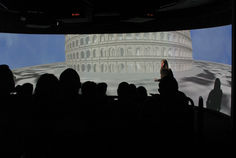
Figure 3. Students experiencing the Flavian Amphitheater in UCLA’s immersive Visualization Portal.
For this digital humanities course, lectures on Roman architecture were interspersed with exercises and workshops that relied heavily on peer-to-peer learning. Short class activities (dubbed “mind raves”) challenged students to develop a position in relation to an issue covered in class lecture and propose an appropriate digital means to convey the argument; the results were peer reviewed. These debates drew upon the students’ rich and varied collective knowledge of digital media and its capabilities for inquiry, analysis and presentation. For example, in one case, urban design students argued for the use of animated programming diagrams to show the sequence through a Roman bath. Those from an art history background felt a three-dimensional model would better convey the immersive experience, while classics students recommended pop-up windows of texts to integrate ancient voices with spaces.
An initial lab-based workshop demonstrated the capabilities of HyperCities, but most learning was through doing. Instructor and peer evaluations were made throughout the term, which greatly helped to hone issue definition and the appropriate implementation of digital strategies. Students drew upon diverse methods. Some exploited the tenets of “experimental archaeology,” which advocates controllable, imitative experiments to replicate past phenomena. For the most part, early experimental archaeology testing was small in scale, primarily recreating known, portable objects; digital tools now facilitate the creation of large architectural and urban simulations. One student group studied the construction process for the Pont du Gard aqueduct (Figure 4), testing several different types of scaffolding based on the archaeological remains, ancient images, Roman architectural handbooks, and post-antique examples of formwork.
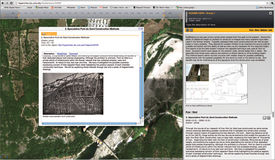
Figure 4. Screenshot of interactive HyperCities platform showing a student project analyzing alternative structural scaffolding solutions for a Roman aqueduct.
The technical sophistication of digital technologies inspired the adoption of scientific models, in particular hypothesis testing. In effect, HyperCities became a laboratory for historical humanistic inquiry. Two creative experiments demonstrated the value of such interdisciplinarity. One group explored how theater design might have evolved in the Roman world without the influence of Greek models. After identifying and isolating Greek architectural features, students analyzed religious, social, political and construction techniques on the Italian peninsula. Their final project featured all the supporting materials, written analysis and a hypothetical design for a “born-Roman” theater presented in the three-dimensional model and animation (Figure 5).

Figure 5. Screenshot of interactive HyperCities platform showing a group project which used images, lines of association, text and an animation to explore the hypothetical appearance of a Roman theater devoid of Greek influences.
Another group explored why the Claudian port at Ostia failed not long after its construction; drawing upon analyses of tidal movement, ship types, use patterns, artistic representations, mole design and available ancient technologies, the students proposed an alternative site and design for the harbor of Rome (Figure 6).
Figure 6. Screenshot of interactive HyperCities platform showing a group project demonstrating possible redesign solutions to improve the port of ancient Rome.
The direct confrontation of geography and mapping in HyperCities significantly enriched the work produced by the class. All the student projects were multidimensional in every sense of the word. The platform’s geographic emphasis showcased spatiality and the vertical (Z) dimension in analyses. In addition, the collaborative approach did more than foster interdisciplinarity—it made it a necessity. Every project drew upon materials and methods from numerous academic fields. Examining the motivations for locating a major highway under a temple platform, one group created a three-dimensional model of the site that underscored the site’s logistical advantages; analysis of religious, economic, geographic, and architectural issues demonstrated that the tunnel was utilized to monitor and tax livestock to Rome during the Republic, as well as meet cult needs. Another group examined how extensive rebuilding at Pompeii after the earthquake of 62 CE resulted in municipal adjustments to traffic flow including such creative solutions as a proscribed circular route for vehicles carrying construction materials and debris (Figure 7), a study that combined urban planning, technology, demography, and archaeology.
Figure 7. Screenshot of interactive HyperCities platform showing a group project analyzing traffic densities and construction routes in Pompeii.
Certainly, such approaches could have been undertaken before the advent of digital humanities, and without the aid of an externally funded program. Nonetheless, they were never tried. Digital technologies stimulate spatial and chronological thinking and collaborative, multidisciplinary engagement. The geotemporal HyperCities platform obliged students to engage constantly and simultaneously with time and space, text, and multimedia. Students developed and articulated their ideas in written arguments, models, graphs, images, films and other media directly situated within the geo-browser. Non-verbal components thus gained equality with words in the process of argumentation. Overall, the perceived need to justify the new technologies led to the assessment of means as well as results. Students perceptively discussed the enduring predominance of the visual in digital humanities projects and critiqued the challenges of selecting the most appropriate digital tool, platform and software. Most productive of all was the interrogation of humanistic research in general in the last class session; students and instructor together debated the definition of humanistic inquiry and the application of digital tools to facilitate the analytical, critical and speculative methods to study the human condition.
Visual Argumentation in a Digital Laboratory: Roman Spectacle
A third “affiliated” course was adapted from an advanced undergraduate lecture on Roman spectacular entertainments (offered by Christopher Johanson, a classicist). Rather than integrate digital production throughout the course, the first seven weeks focused instead on detailed historical and chronological study of Roman spectacle. Opening with a clear theoretical approach to the Roman notion of spectacula—events that offered opportunities to see and be seen—the course began with an examination of the aristocratic funeral of the Roman republic, which amassed many of the key components of early spectacular stagecraft, and progressed to the apex of Roman imperial shows, staged in purpose-built complexes, attended by thousands. Lectures surveyed ad hoc, ephemeral spectacle of the city of Rome, power dynamics on display during planned events, the visual competition of symbolic capital, the role of the gladiator and the martyr in Roman society, and practical matters of staging such significant, spectacular entertainments.
The first segment of the course followed a fairly traditional, lecture and discussion program, save that born-digital material served as the foundation for presentations. Each week’s readings were framed within digital “tinker-toy models”9 representing monumental spaces of the urban environment of ancient Rome (Figure 8). Rather than receive an unmediated presentation of these reconstructed spaces, students were first given a short critical introduction to epistemological issues related to studying hypothetical—and often controversial—representations of an ancient city and its historical events.10 Students examined different experimental attempts to describe daily life in the city, which ranged from standard encyclopedic entries to historical-fictional attempts to study the experience of Roman daily life. They interrogated digital reconstructions, not as attempts to reproduce a past reality, but as hermeneutical tools and experimental laboratories. Each subsequent week’s lecture was steeped in representations of ancient spectacle. Each study built on the last, laying the foundation in the Roman Forum, the heart of large-scale public spectacle, then moving through the narrow surrounding arteries to examine Roman street theater, and then fast-forwarding through time to situate discussions within digital representations of the Flavian Amphitheater and Circus Maximus coupled with filmic depictions of the two. The midterm exam asked students to demonstrate their broad command of the overall historical development of spectacle, discuss the definition of spectacle at Rome, and show specific knowledge of core concepts and key technical terminology.
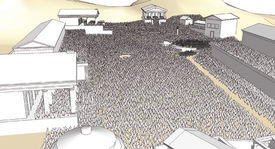
Figure 8. A digital “tinker-toy” model of the Roman Forum of the Middle Republic.
The students’ role in the course shifted dramatically from that of content consumers to producers after week seven, when the parameters of the final project were fully revealed. Asked to synthesize work from the first section of the course, they would develop a narrative that discussed the transformation of spectacular entertainment and stagecraft in the Roman world by examining three distinct time periods. Their digital project—a fusion of two-dimensional mapping and three-dimensional world building—illustrated, augmented and enhanced a paper-based narrative. They were, on the one hand, tasked with illustrating their own work with their own digital creations, but also, more importantly, encouraged to develop arguments that could only be made by using space-based argumentation.
Though some students were motivated to become three-dimensional modelers, many had little experience working with three-dimensional content. Rather than start from scratch, students were given pre-built content to develop the three-dimensional lab. By using digital reconstructions developed in earlier projects at the UCLA Cultural VR Lab (http://www.cvrlab.org/) and the UCLA Experiential Technologies Center, students had a pre-built set of three-dimensional iconography to be used in their mapping exercises. Of course, they could (and did) manipulate the pieces and populate them with their own representations of crowds or performers.
Nearly half the twenty-four students in the class presented arguments that had equally compelling visual and textual components. One project interrogated large-scale entertainment venues to contend that imperial power manifest itself through an overt control of the spectacular spaces (Figure 9). Another traced the lineage of funerary image manipulation, situating the use of the bloody clothes of Caesar at his funeral within the larger context of visual storytelling at the Roman funeral (Figure 10). Another focused on the transformation of monumental billboards, beginning with the political sponsorship of Roman games, transitioning to the permanent, named spaces that would honor their dedicator during the staging of each event, and culminating with the development of pure propaganda such as that illustrated in the Imperial, triumphal arch. A final example compared the changing nature of audience participation at the theater in Rome to that of the nineteenth-century United States (Figure 11).
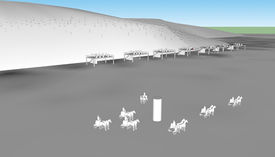
Figure 9. An experimental representation of the natural depression where early circus games might have been held in Rome.
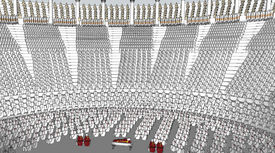
Figure 11. The cavea of the Theater of Marcellus filled with spectators whose clothing clearly indicate a seating system defined by social class.
The evaluation process was critical to the success of the course. The raw digital material was not evaluated for craft or technique. Instead, students were asked to transform their visual, interactive argument into a short six-minute performance given during finals week. Therefore, preparation and ideas could be evaluated independently of the digital ability of the student, and each successful presentation focused first on the humanistic problem rather than digital fireworks.
A “Core” Curriculum in Digital Mapping at UCLA
While most of the courses associated with the Keck DCMP, including those discussed above, are firmly grounded within specific academic departments, the “core” courses by design are intended to teach students across many disciplines. This approach has its advantages, but it also results in a number of methodological hurdles. For example, the Core B Course, centered on lab-style digital technology instruction, is designed to engage students actively in creating individual projects using digital mapping software such as GIS, virtual globes, and three-dimensional modeling. Students enrolled in the first year of the program came from seven different majors, with interests that ranged across the globe and spanned ancient to modern times. While it would likely be easier to teach this course simply as a series of technological tutorials, it is vital to our mission that students grapple with the technological and Humanistic questions simultaneously. How does one evaluate projects with such a diverse focus successfully?
In this class, we found a solution in the fundamentals of humanistic inquiry, which essentially do not change across department or disciplines. Be it history, archaeology, cultural studies or English, we follow similar rules for research problem design, demand the same rigor in data collection, and expect the same critical analysis of our results. With this in mind, we asked students to learn and experiment with the capabilities of the various technologies taught in class, focusing on what each platform could and could not do well, and how the visualization of the data differed from one to the other. As the course progressed, and students began to distinguish strengths and weaknesses of the different platforms, they were asked to create a series of projects on a topic within their own major field of interest. Each project’s design was required to take advantage of the strengths of each platform, capitalizing on the platform’s organizational and visualization capabilities to address a research question (Figures 12 and 13). Datasets must be appropriate for answering the desired question, and visualized in a clear and well-designed manner for expressing one’s argument. Students presented their digital projects in class or posted them to the class website, and fellow students were asked to critique each other’s projects for design, clarity and strength of conclusions.
Figure 12. Screenshot of a student project investigating the cultural and economic impact of New York City’s High Line Park.
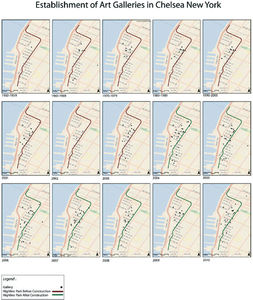
Figure 13. Iterative GIS maps of the growth of art galleries related to the opening of the High Line Park show its cultural influence; a three-dimensional model examines its relationship with the neighborhood.
Essentially, we discovered that the constant focus on digital design in practice—such as color, size and location for objects and lines added to a two-dimensional web-based mapping project, or the folder organization in a virtual globe project allowing different groups of objects/lines/polygons to be turned “on” or “off” collectively—led to added focus on the initial research design of the project. By thinking through how the project would be organized and appear in the digital environment, students had to think critically about the individual and collective meaning of each piece of information brought into the project: What is its meaning as entered? Could it be interpreted or represented in a different way? How would changing its representation affect results? How does it relate to other types of data in the project? Here, then, lies an opportunity to integrate our study of the humanities and social sciences with the digital toolbox, and our means to evaluate such a wide-range of student research projects. By assessing whether research design is (1) appropriate to the platform used, and (2) appropriate to the research question asked, both the instructor and fellow students can provide a broad critique of work outside our own areas of interest. This cuts to the heart of what it means to teach digital literacy and, in effect, offered a practical approach to teaching critical cartography.
In the case of this class, the platform was a digital one, but the skills honed to develop a research question and match it to an appropriate means of analysis and presentation of data apply to research in many formats and disciplines. By continually addressing questions of how research design and presentation influence the outcome of a project—both within their own projects and in their review of fellow students’ projects—students sharpened their critical thinking skills and made real strides in identifying problems in argumentation or visualization.
A more difficult area for critique lay in the evaluation of a student’s dataset. Indeed, it is impossible for any instructor (in the case of the first offering of Core Course B, Elaine Sullivan, an Egyptologist) to have in-depth knowledge of the types of sources available in a myriad of disciplines, which, in one class, included Chinese archaeology, modern American architecture, and ethnicity in early twentieth century Los Angeles. Student projects could not be assessed for completeness of the dataset, as the bibliography of source material used in most cases could not be fully evaluated by a non-specialist. The spatial aspect of each of the datasets gave both students and instructor a set of similar points on which to begin a critique. Initial questions spurred by the visualization of the dataset included issues of change over time, techniques of data collection, gaps in the datasets, size and completeness of the dataset, and reliability of data. In some cases the collaborative nature of the projects, which underwent a series of reviews by fellow students in class and on the online forums, provided even more substantive analysis. Students with majors or minors in the same fields gave subject-specific critiques and recommendations on sources used for their peers’ projects. The varied nature of the data also meant that students (and the instructor) encountered dataset issues unfamiliar to them from their own fields. Class participants had to try to solve data collection issues creatively, often leading to inventive and insightful strategies that may not have occurred to those within the same discipline.
On the whole, we approached this skills class as a testing ground for incorporating digital methodologies into traditional humanistic questions. We hoped that students would take the technological and critical-thinking skills back into their departmental coursework, where future projects could and would be evaluated by subject specialists. Thus, while questions of dataset conceptualization and visualization are of utmost importance, for this approach we left the assessment of the accuracy and fullness of the dataset itself to another time. In fact, a number of our students mapped out projects for which the gathering of a complete dataset would take more than the few weeks available in UCLA’s ten-week quarter system. They saw their final projects as only preliminary results, providing examples of how more data-rich projects could appear. What is vital for this course is not the gathering of such rich sets of data, but the articulation of what should be in the dataset, how this information should be organized and visualized, what cannot or should not be included (e.g., due to the quality and nature of the original data, the definition of the problem to be solved, or the level of representational granularity stated in the project design), and a demonstration of what these preliminary results would look like.
The final step in each mapping project asked students to evaluate the results of their data visualization. Early in the quarter, the entire class was provided with a large dataset of published archaeological finds from an ancient city. Each student mapped a section of the dataset in order to investigate a specific question about the possible function of different sections of the city. They then drew conclusions based on their digital map. When presented to their peers, the students were amazed by how many different conclusions about neighborhood function emerge from the same set of data (Figures 14, 15, and 16). This exercise was specifically designed to spur their thinking about how data is interpreted.
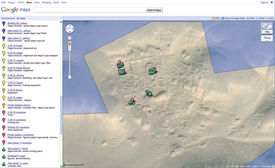
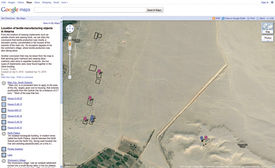
Figures 14, 15, and 16. Screenshots of three student projects mapping the same dataset. One student chose to map the full dataset by function, a second by material, the third mapped out only selective data related to a specific topic.
A large part of the evaluation of each student project rests on how they have created and supported their argument with the data. In digital projects, this often means including screenshots of one’s GIS maps or views of one’s virtual globe as figures within a traditional written paper. In other cases, students add their thesis directly to the digital platform and create an argument their viewers must follow within the digital space. In both cases, projects are critiqued on the basic premise of good scholarship: has the author successfully argued that the data supports their conclusions? Ultimately, the visual nature of these digital platforms leads students to engage with the data in a more sophisticated way, encouraging better analysis and more thoughtful conclusions, more interesting papers and projects, and what we hope to be real, “immersive” learning that transfers to other aspects of their academic lives.11
The Program in Digital Humanities at UCLA
The collective institutional experience at UCLA in digital tool development, as well as the advanced study of theoretical approaches in digital cultural mapping, enabled through the in-class digital laboratory, supplied ample foundation upon which to build not only an exciting experimental and highly-focused program, but also a fully-fledged, more broadly conceived, curriculum for undergraduate and graduate education. We saw the natural outcome of this three-year program in digital cultural mapping as the creation of a more far-reaching program in Digital Humanities, one that would remain project-specific but would expand to comprise corpora analysis, text and data visualization, and social research on a significantly larger scale. We modeled our expanded curriculum on the specific research profiles of practicing digital humanists. Our own variegated paths to the production of digitally enabled scholarship and digital humanities research had each started in a traditionally defined—albeit extraordinarily progressive—humanities program. We self-identified as Egyptologists, architectural historians, classicists, urban historians, archaeologists and the like, while we also increasingly began to immerse ourselves in the literature that had coalesced over time around the idea that has now become the digital humanities. We hoped to record those paths, generalize them where appropriate, and turn them into a program in which our students would be equipped to participate in current scholarly conversations in humanities-based disciplines. A scholar’s contribution to Roman studies, for example, is handicapped if he or she does not have a firm grounding in the discipline’s theoretical approaches, its canonical literature, its current research themes, the tone of the present scholarly conversation and the directions of the hottest topics. Our time with students is extraordinarily limited, and though we might wish to teach critical approaches to map-based visualization, for example, digital humanities courses necessarily must connect to the roots of the humanities. Otherwise should they not instead be called digital studies, media studies or information studies? When the focus is on geospatial digital research design for the humanities, developed in discipline-specific environments, then those roots are firmly grounded.
The paradox inherent in a digitally-centered program is that undergraduates are actually much better prepared to make significant contributions to traditional research areas through their digital experience than through their undergraduate training in traditionally defined disciplines. A sophomore majoring in near eastern languages and cultures has received a minimal introduction to the field. A senior majoring in classics can, in all but the rarest exceptions, claim to have received only a broad introduction to texts, material evidence, the research methodologies, tools and approaches to scholarship. In general, we cannot expect an undergraduate major in architectural theory to participate in an undergraduate seminar as an expert architectural historian. We can, however, expect to see a budding digital humanist, with broad training in his or her domain-specific discipline, approach a traditional problem in a radically new way, or conceive of an entirely fresh approach to the traditionally defined field.
We created a program intended to highlight our specific institutional strengths in digital humanities project development and our internal focus on training students in domain-specific areas, while at the same time engaging in the current digital humanities conversation. The Keck Digital Cultural Mapping Program offered us a rare luxury in academia: we were able to experiment with a radical alteration of a curriculum and traditional teaching methodologies, which resulted both in valuable teaching and learning experience and in the creation of an official course of study for those interested in combining the digital with the humanistic. In the winter of 2011, we successfully launched an undergraduate minor and graduate certificate program at UCLA,12 both of which are project-based, humanities-focused, but tailored to give students the flexibility to explore serious humanities questions in ways hitherto impossible to imagine.
Footnotes
1 For a historical review of “the spatial turn,” as it has developed in a number of disciplines, see Joanna Guldi, “What is the Spatial Turn?” Spatial Humanities, Institute for Enabling Geospatial Scholarship, n.d., http://spatial.scholarslab.org/spatial-turn/. For evidence of projects on the ground, see the print-based, circa 2010 state-of-theart survey by David J. Bodenhamer in The Spatial Humanities: GIS and the Future of Humanities Scholarship (Bloomington: Indiana University Press, 2010). For a cautionary note on “borrowing” technologies from other disciplines and a call-to-arms to focus on humanistic visualizations, see Johanna Drucker, “Humanities Approaches to Graphical Display,” Digital Humanities Quarterly 5, no. 1 (2011): paras. 1–52.
2 We have only begun to teach how to interrogate multi-dimensional maps in a way that approaches that articulated in Charles Goodwin, “Professional Vision,” American Anthropologist 96 (1994): 606–33.
3 Assigned texts range from the rudimentary but still extraordinarily compelling Mark Monmonier, How to Lie with Maps, 2nd edn (Chicago: University of Chicago Press, 1996) to David Rumsey and Meredith Williams, “Historical Maps in GIS,” in Past Time, Past Place: GIS for History, ed. Anne Kelly Knowles (San Diego: ESRI Press, 2002), 1–18, and Edward R. Tufte, Visual Explanations: Images and Quantities, Evidence and Narrative (Cheshire: Graphics Press, 1997).
4 For an overview on the technological savvy of the so-called millennials, see Sue Bennett, Karl Maton, and Lisa Kervin, “The ‘Digital Natives’ Debate: A Critical Review of the Evidence,” British Journal of Educationala Technology 39, no. 5 (2008): 775–86, and Neil Selwyn, “The Digital Native: Myth and Reality,” Aslib Proceedings 61, no. 4 (2009): 364–79.
5 For a discussion of these issues, see Simon Mahony and Elena Pierazzo’s chapter “Teaching Skills or Teaching Methodology?”
6 For a discussion of such a course as successfully offered at the University of Nebraska–Lincoln, see Stephen Ramsay’s chapter “Programming with Humanists: Reflections on Raising an Army of Hacker-Scholars in the Digital Humanities.”
7 This echoes the findings of Mahony and Pierazzo, “Teaching Skills or Teaching Methodology?”
8 Many developed skills in HTML and KML, and in the process required to geo-reference imagery and add it to platforms such as HyperCities. An undercurrent of our program’s focus is to balance the use of experimental projects with that of software and standards supported by academia and industry. As evidenced by the use of KML for geospatial markup, we sometimes use the more widely adopted standard in preference to the more robust.
9 On “tinker-toy models,” see Willard McCarty, “Modeling: A Study in Words and Meanings,” in A Companion to Digital Humanities, ed. Susan Schreibman, Ray Siemens, and John Unsworth (Malden: Blackwell, 2004), 254–70. As applied to historical reconstructions, see Christopher Johanson, “Visualizing History: Modeling in the Eternal City,” Visual Resources: An International Journal of Documentation 25, no. 4 (2009): 403-18.
10 Diane Favro, “In the Eye of the Beholder: Virtual Reality Re-Creations and Academia,” Journal of Roman Archaeology, Supplementary Series 61 (2006): 321–34.
11 Such project-based approaches to curriculum are hardly new, but it is clear that recent focus on immersive learning, such as the immersive learning initiative at Ball State University, is directly enabled by digital technology; see “What is Immersive Learning,” Strategic Plan 2007–2012, Ball State University, October 5, 2011, http://cms.bsu.edu/About/StrategicPlan/WhatisImmersiveLearning.aspx.
12 The University of California system does not offer a minor at the graduate level, but instead provides a “graduate certificate” program. The terminology is confusing, especially considering that industry-sponsored certifications run rampant in the digital world. For a compelling discussion of a digital humanities certificate program endorsed by the digital humanities community at large, see Lisa Spiro’s chapter, “Opening Up Digital Humanities Education.”




